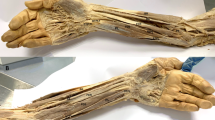ABSTRACT
Palmaris longus muscle, although of little functional use to the human upper limb, assumes great importance when used as a donor tendon for transfer or transplant. The variability in the prevalence of palmaris longus agenesis among various ethnic groups has been established, and the surgeon’s awareness of the prevalence in a population or ethnic group is desirable. The prevalence of palmaris longus agenesis has, to the best of the authors’ knowledge, not been reported in Indian patients. Five hundred Indian patients were examined for the presence or absence of palmaris longus tendon, using the conventional test for presence of palmaris longus. The prevalence and pattern of palmaris longus agenesis was analyzed statistically and any difference in prevalence or pattern of palmaris longus agenesis with regard to body side or sex was looked for. All statistical analysis was done using SPSS (version 12). ÷ 2 test was used to analyze the association of agenesis with limb laterality and sex. The prevalence of palmaris longus agenesis was found to be 17.2% (8% bilateral and 9.2% unilateral). The prevalence of agenesis was significantly more common on the left side. Male subjects had a greater likelihood of unilateral agenesis, while female subjects were more likely to have bilateral agenesis. That prevalence of palmaris longus agenesis is race dependent is reaffirmed in the present study. Although the prevalence of palmaris longus agenesis in Indian patients was found to be much higher than the reported average prevalence in an Asian population, this tendon can still be counted on by surgeons treating Indian patients for use as a donor tendon, which will be present in a vast majority of Indian patients.
Similar content being viewed by others
References
Bachelor EP, Jobe RP (1980) The absent lateral canthal tendon: Reconstruction using a Y graft of palmaris longus tendon. Ann Plast Surg 5, 362–8.
Ceyhan O, Mavt A (1997) Distribution of agenesis of palmaris longus muscle in 12–18 years old age groups. Indian J Med Sci 51, 156–60.
Connoly WB, Kilgore ES, Jr. (1977) Tendons. In: The Hand: Surgical and Nonsurgical Management (Kilgore ES, Graham WP, eds). Lea & Febiger, Philadelphia, 162–210.
Kendall FP, McCreary EK, Provance PG, eds. (1993) Upper extremity and shoulder girdle strength tests. In: Muscles Testing and Function, 4th edn. Williams & Wilkins, Baltimore, 237–98.
Martinoli C, Bianchi S, Dahmane M, Pugliese F, BianchiZamorani MP, Valle M (2002) Ultrasound of tendons and nerves. Eur Radiol 12, 44–55.
Oudit D, Crawford L, Juma A, Howcroft A (2005) Am Soc Plast Surg 116, 691–2.
Pratt NE (1995) Surface anatomy of upper extremity. In: Rehabilitation of the Hand- Surgery and Therapy, Vol. I, 4th edn (Hunter JM, Mackin EJ, Callahan AD, eds). Mosby, St Louis, 41–50.
Pushpakumar SB, Hanson RP, Carroll S (2004) The ‘two-finger’ sign: Clinical examination of palmaris longus tendon. Br J Plast Surg 57, 184.
Reimann AF, Daseler EH, Anson BJ, Beaton LE. (1944) The palmaris longus muscle and tendon; a study of 1600 extremities. Anat Rec 89, 495–505.
Schaeffer JP (1909) On the variations of the palmaris longus muscle. Anat Rec 3, 275–8.
Sebastin SJ, Puhaindran ME, Lim AY, Lim IJ, Bee WH. (2005) The prevalence of absence of the palmaris longus: A study in a Chinese population and a review of the literature. J Hand Surg [Br] 30, 525–7.
Song IC, Bromberg BE (1974) Pharyngo-palatoplasty with free transplantation of the palmaris longus. Br J Plast Surg 27, 337–43.
Thompson NW, Mockford BJ, Cran GW (2001) Absence of the palmaris longus muscle: A population study. Ulster 70, 22–4.
Van de Graff KM (1995) Muscular system. In: Human Anatomy, 4th edn (Van de Graff KM, ed.). Wm.C. Brown, Iowa, 224–82.
Wright PE II (2003) Flexor and extensor tendon injuries. In: Campbell’s Operative Orthopedics, 10th edn (Canale ST, ed.). Mosby, Philadelphia, 3423–81.
Author information
Authors and Affiliations
Corresponding author
Rights and permissions
About this article
Cite this article
Kapoor, S.K., Tiwari, A., Kumar, A. et al. Clinical relevance of palmaris longus agenesis: common anatomical aberration. Anato Sci Int 83, 45–48 (2008). https://doi.org/10.1111/j.1447-073X.2007.00199.x
Received:
Accepted:
Issue Date:
DOI: https://doi.org/10.1111/j.1447-073X.2007.00199.x




